王之泰201771010131《面向对象程序设计(java)》第九周学习总结
第一部分:理论知识学习部分
第7章异常、日志、断言和调试
概念:异常、异常类型、异常声明、异常抛出、 异常捕获
1.异常处理技术
2.断言的概念及使用
3.基本的调试技巧
1)异常的概念
a.Java的异常处理机制可以控制程序从错误产生的 位置转移到能够进行错误处理的位置。
b.程序中出现的常见的错误和问题有:用户输入错误 ;设备错误 ;物理限制 ;代码错误。
2)异常分类:
a.非致命异常:通过某种修正后程序还能继续执行。 这类错误叫作异常。如:文件不存在、无效的数组 下标、空引用、网络断开、打印机脱机、磁盘满等。 Java中提供了一种独特的处理异常的机制,通过异 常来处理程序设计中出现的错误。
b.致命异常:程序遇到了非常严重的不正常状态,不 能简单恢复执行,是致命性错误。如:内存耗尽、 系统内部错误等。这种错误程序本身无法解决。
3) Java中所有的异常类都直接或间接地继承于 Throwable类。除内置异常类外,程序员可自定义异 常类。
Java中的异常类可分为两大类:
a.Error Error类层次结构描述了Java运行时系统的内部错误 和资源耗尽错误。应用程序不应该捕获这类异常,也 不会抛出这种异常。
b.Exception Exception类:重点掌握的异常类。Exception层次结 构又分解为两个分支:一个分支派生于 RuntimeException;另一个分支包含其他异常
第二部分:实验部分 ——异常、断言与日志
1、实验目的与要求
(1) 掌握java异常处理技术;
(2) 了解断言的用法;
(3) 了解日志的用途;
(4) 掌握程序基础调试技巧;
2、实验内容和步骤
实验1:用命令行与IDE两种环境下编辑调试运行源程序ExceptionDemo1、ExceptionDemo2,结合程序运行结果理解程序,掌握未检查异常和已检查异常的区别。
//异常示例1
public class ExceptionDemo1 {
public static void main(String args[]) {
int a = 0;
System.out.println(5 / a);
}
}
//异常示例2
import java.io.*; public class ExceptionDemo2 {
public static void main(String args[])
{
FileInputStream fis=new FileInputStream("text.txt");//JVM自动生成异常对象
int b;
while((b=fis.read())!=-1)
{
System.out.print(b);
}
fis.close();
}
}
检查异常后:
package 异常; //异常示例1
public class ExceptionDemo1 {
public static void main(String args[]) {
int a=0;
if(a==0) {
System.out.println("除数为零!");
}
else {
System.out.println(5 / a); }
}
}
package 异常; //异常示例2
import java.io.*; public class ExceptionDemo2 {
public static void main(String args[]) throws Exception
{
FileInputStream fis=new FileInputStream("text.txt");//JVM自动生成异常对象
int b;
while((b=fis.read())!=-1)
{
System.out.print(b);
}
fis.close();
}
}
在项目文件夹中添加相应的TXT文件
实验2: 导入以下示例程序,测试程序并进行代码注释。
测试程序1:
1.在elipse IDE中编辑、编译、调试运行教材281页7-1,结合程序运行结果理解程序;
2.在程序中相关代码处添加新知识的注释;
3.掌握Throwable类的堆栈跟踪方法;
7-1代码如下:
package stackTrace; import java.util.*; /**
* A program that displays a trace feature of a recursive method call.
* @version 1.01 2004-05-10
* @author Cay Horstmann
*/
public class StackTraceTest
{
/**
* Computes the factorial of a number
* @param n a non-negative integer
* @return n! = 1 * 2 * . . . * n
*/
public static int factorial(int n)
{
System.out.println("factorial(" + n + "):");
Throwable t = new Throwable();//调用Throwable类的getStackTrace方法,得到StackTraceElement对象的一个数组
StackTraceElement[] frames = t.getStackTrace();
for (StackTraceElement f : frames)
System.out.println(f);
int r;
if (n <= 1) r = 1;
else r = n * factorial(n - 1);
System.out.println("return " + r);
return r;
} public static void main(String[] args)
{
Scanner in = new Scanner(System.in);
System.out.print("Enter n: ");
int n = in.nextInt();
factorial(n);
}
}
程序运行结果如下:
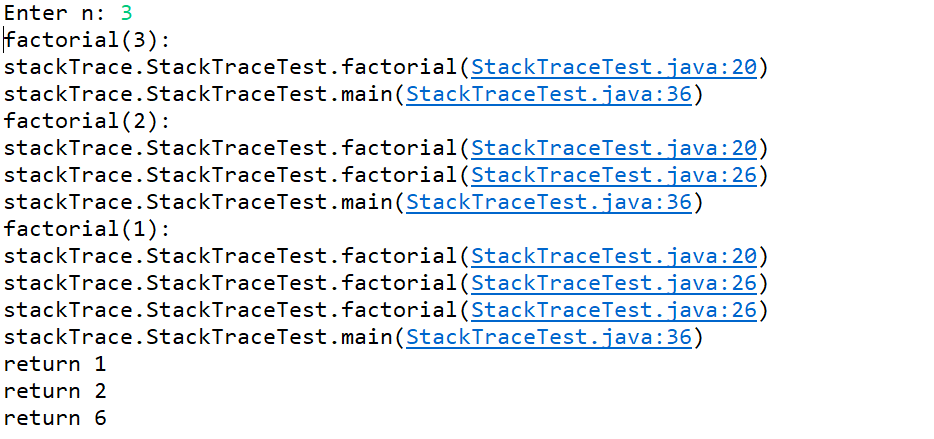
测试程序2:
1.Java语言的异常处理有积极处理方法和消极处理两种方式;
2.下列两个简答程序范例给出了两种异常处理的代码格式。在elipse IDE中编辑、调试运行源程序ExceptionalTest.java,将程序中的text文件更换为身份证号.txt,要求将文件内容读入内容,并在控制台显示;
3.掌握两种异常处理技术的特点。
//积极处理方式
import java.io.*; class ExceptionTest {
public static void main (string args[])
{
try{
FileInputStream fis=new FileInputStream("text.txt");
}
catch(FileNotFoundExcption e)
{ …… }
……
}
}
//消极处理方式 import java.io.*;
class ExceptionTest {
public static void main (string args[]) throws FileNotFoundExcption
{
FileInputStream fis=new FileInputStream("text.txt");
}
}
读入内容后:
package 异常; //积极处理方式
import java.io.*;
import java.io.BufferedReader;
import java.io.FileReader; class ExceptionTest {
public static void main (String args[])
{
File fis=new File("身份证号.txt");
try{ FileReader fr = new FileReader(fis);
BufferedReader br = new BufferedReader(fr);
try {
String s, s2 = new String();
while ((s = br.readLine()) != null) {
s2 += s + "\n ";
}
br.close();
System.out.println(s2);
} catch (IOException e) {
// TODO Auto-generated catch block
e.printStackTrace();
}
} catch (FileNotFoundException e) {
// TODO Auto-generated catch block
e.printStackTrace();
} }
}
package 异常; //消极处理方式 import java.io.*;
class ExceptionTest {
public static void main (String args[]) throws IOException
{
File fis=new File("身份证号.txt");
FileReader fr = new FileReader(fis);
BufferedReader br = new BufferedReader(fr);
String s, s2 = new String(); while ((s = br.readLine()) != null) {
s2 += s + "\n ";
}
br.close();
System.out.println(s2);
}
}
实验3: 编程练习
练习1:
1.编制一个程序,将身份证号.txt 中的信息读入到内存中;
2.按姓名字典序输出人员信息;
3.查询最大年龄的人员信息;
4.查询最小年龄人员信息;
5.输入你的年龄,查询身份证号.txt中年龄与你最近人的姓名、身份证号、年龄、性别和出生地;
6.查询人员中是否有你的同乡;
在以上程序适当位置加入异常捕获代码。
package IDcard; import java.io.BufferedReader;
import java.io.File;
import java.io.FileInputStream;
import java.io.FileNotFoundException;
import java.io.IOException;
import java.io.InputStreamReader;
import java.util.ArrayList;
import java.util.Scanner;
import java.util.Collections; public class ID { public static People findPeopleByname(String name) {
People flag = null;
for (People people : peoplelist) {
if(people.getName().equals(name)) {
flag = people;
}
}
return flag; } public static People findPeopleByid(String id) {
People flag = null;
for (People people : peoplelist) {
if(people.getnumber().equals(id)) {
flag = people;
}
}
return flag; } private static ArrayList<People> agenear(int yourage) {
// TODO Auto-generated method stub
int j=0,min=53,d_value=0,k = 0;
ArrayList<People> plist = new ArrayList<People>();
for (int i = 0; i < peoplelist.size(); i++) {
d_value = peoplelist.get(i).getage() > yourage ?
peoplelist.get(i).getage() - yourage : yourage - peoplelist.get(i).getage() ;
k = d_value < min ? i : k;
min = d_value < min ? d_value : min;
}
for(People people : peoplelist) {
if(people.getage() == peoplelist.get(k).getage()) {
plist.add(people);
}
}
return plist;
} private static ArrayList<People> peoplelist; public static void main(String[] args) //throws IOException
{
peoplelist = new ArrayList<People>();
Scanner scanner = new Scanner(System.in);
File file = new File("D:\\身份证号.txt");
try {
FileInputStream files = new FileInputStream(file);
BufferedReader in = new BufferedReader(new InputStreamReader(files));
String temp = null;
while ((temp = in.readLine()) != null) { String[] information = temp.split("[ ]+");
People people = new People();
people.setName(information[0]);
people.setnumber(information[1]);
int A = Integer.parseInt(information[3]);
people.setage(A);
people.setsex(information[2]);
for(int j = 4; j<information.length;j++) {
people.setplace(information[j]);
}
peoplelist.add(people); }
} catch (FileNotFoundException e) {
System.out.println("文件未找到");
e.printStackTrace();
} catch (IOException e) {
System.out.println("文件读取错误");
e.printStackTrace();
}
boolean isTrue = true;
while (isTrue) { System.out.println("******************************************");
System.out.println(" 1.按姓名典序输出人员信息");
System.out.println(" 2.查询最大年龄人员信息");
System.out.println(" 3.查询最小年龄人员信息");
System.out.println(" 4.输入你的年龄,查询身份证号.txt中年龄与你最近的人");
System.out.println(" 5.查询人员中是否有你的同乡");
System.out.println(" 6.退出");
System.out.println("******************************************");
int nextInt = scanner.nextInt();
switch (nextInt) {
case 1:
Collections.sort(peoplelist);
System.out.println(peoplelist.toString());
break;
case 2:
int max=0;
int j,k1 = 0;
for(int i=1;i<peoplelist.size();i++)
{
j = peoplelist.get(i).getage();
if(j>max)
{
max = j;
k1 = i;
} }
System.out.println("年龄最大:"+peoplelist.get(k1));
break;
case 3:
int min = 100;
int j1,k2 = 0;
for(int i=1;i<peoplelist.size();i++)
{
j1 = peoplelist.get(i).getage();
if(j1<min)
{
min = j1;
k2 = i;
} }
System.out.println("年龄最小:"+peoplelist.get(k2));
break;
case 4:
System.out.println("年龄:");
int input_age = scanner.nextInt();
ArrayList<People> plist = new ArrayList<People>();
plist = agenear(input_age);
for(People people : plist) {
System.out.println(people.toString());
}
break;
case 5:
System.out.println("请输入省份");
String find = scanner.next();
for (int i = 0; i <peoplelist.size(); i++)
{
String [] place = peoplelist.get(i).getplace().split("\t");
for(String temp : place) {
if(find.equals(temp)) {
System.out.println("你的同乡是 "+peoplelist.get(i));
break;
}
} }
break;
case 6:
isTrue = false;
System.out.println("byebye!");
break;
default:
System.out.println("输入有误");
}
}
} }
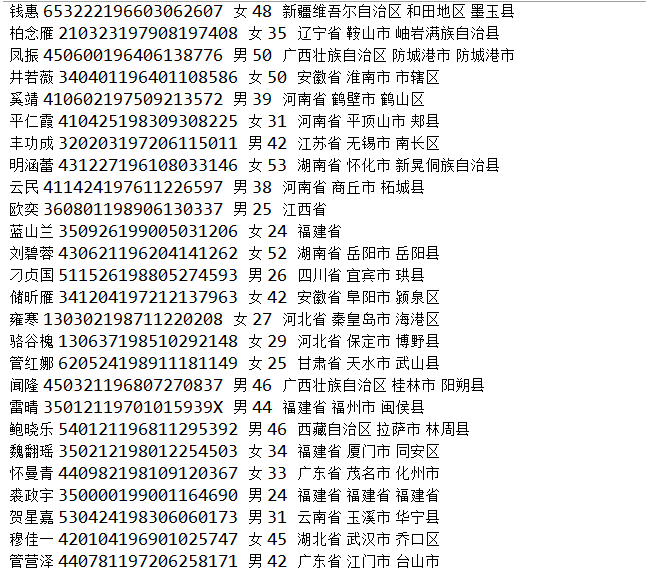
练习2:
1.编写一个计算器类,可以完成加、减、乘、除的操作;
2.利用计算机类,设计一个小学生100以内数的四则运算练习程序,由计算机随机产生10道加减乘除练习题,学生输入答案,由程序检查答案是否正确,每道题正确计10分,错误不计分,10道题测试结束后给出测试总分;
3.将程序中测试练习题及学生答题结果输出到文件,文件名为test.txt;
4.在以上程序适当位置加入异常捕获代码。
程序如下:
package 算术题; import java.io.FileNotFoundException;
import java.io.PrintWriter;
import java.util.Scanner; public class ss {
public static void main(String[] args) { Scanner in = new Scanner(System.in);
sf sf=new sf();
PrintWriter output = null;
try {
output = new PrintWriter("ss.txt");
} catch (Exception e) {
//e.printStackTrace();
}
int sum = 0; for (int i = 1; i < 11; i++) {
int a = (int) Math.round(Math.random() * 100);
int b = (int) Math.round(Math.random() * 100);
int s = (int) Math.round(Math.random() * 4); switch(s)
{
case 1:
System.out.println(i+": "+a+"/"+b+"=");
while(b==0){
b = (int) Math.round(Math.random() * 100);
}
double c = in.nextDouble();
output.println(a+"/"+b+"="+c);
if (c == sf.chu_fa(a, b)) {
sum += 10;
System.out.println("恭喜答案正确");
}
else {
System.out.println("抱歉,答案错误");
} break; case 2:
System.out.println(i+": "+a+"*"+b+"=");
int c1 = in.nextInt();
output.println(a+"*"+b+"="+c1);
if (c1 == sf.chen_fa(a, b)) {
sum += 10;
System.out.println("恭喜答案正确");
}
else {
System.out.println("抱歉,答案错误");
}break;
case 3:
System.out.println(i+": "+a+"+"+b+"=");
int c2 = in.nextInt();
output.println(a+"+"+b+"="+c2);
if (c2 == sf.jia_fa(a, b)) {
sum += 10;
System.out.println("恭喜答案正确");
}
else {
System.out.println("抱歉,答案错误");
}break ;
case 4:
System.out.println(i+": "+a+"-"+b+"=");
int c3 = in.nextInt();
output.println(a+"-"+b+"="+c3);
if (c3 == sf.jian_fa(a, b)) {
sum += 10;
System.out.println("恭喜答案正确");
}
else {
System.out.println("抱歉,答案错误");
}break ; } }
System.out.println("成绩"+sum);
output.println("成绩:"+sum);
output.close(); }
}
package 算术题; public class sf
{
private int a;
private int b;
public int jia_fa(int a,int b)
{
return a+b;
}
public int jian_fa(int a,int b)
{
if((a-b)<0)
return 0;
else
return a-b;
}
public int chen_fa(int a,int b)
{
return a*b;
}
public int chu_fa(int a,int b)
{
if(b!=0)
return a/b;
else
return 0;
} }
结果如下:

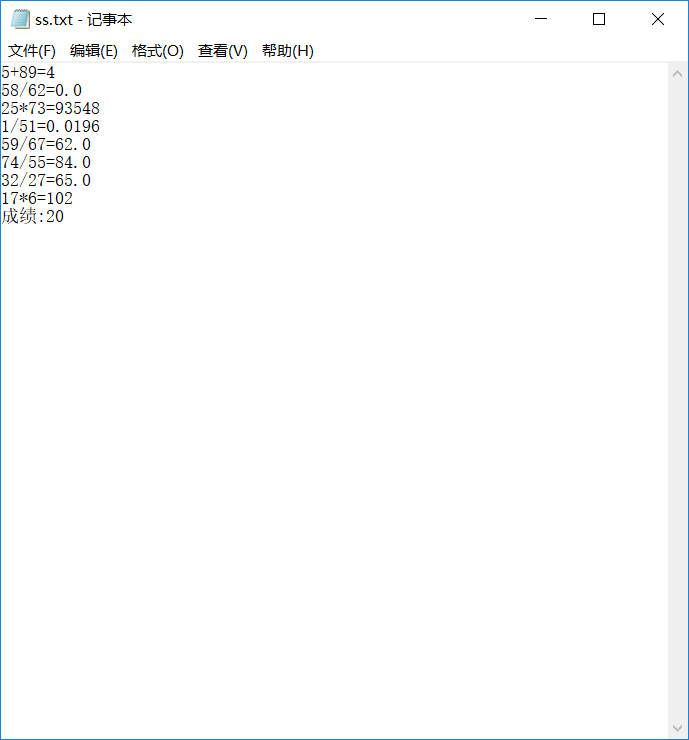
实验4:断言、日志、程序调试技巧验证实验。
实验程序1:
//断言程序示例
public class AssertDemo {
public static void main(String[] args) {
test1(-5);
test2(-3);
} private static void test1(int a){
assert a > 0;
System.out.println(a);
}
private static void test2(int a){
assert a > 0 : "something goes wrong here, a cannot be less than 0";
System.out.println(a);
}
}
1.在elipse下调试程序AssertDemo,结合程序运行结果理解程序;
2.注释语句test1(-5);后重新运行程序,结合程序运行结果理解程序;
3.掌握断言的使用特点及用法。
程序运行结果如下:

注释后程序如下:
package stackTrace;
//断言程序示例
public class AssertDemo {
public static void main(String[] args) {
// test1(-5);
test2(-3);
} private static void test1(int a){
assert a > 0;
System.out.println(a);
}
private static void test2(int a){
assert a > 0 : "something goes wrong here, a cannot be less than 0";
System.out.println(a);
}
}
结果如下:

实验程序2:
1.用JDK命令调试运行教材298页-300页程序7-2,结合程序运行结果理解程序;
2.并掌握Java日志系统的用途及用法。
程序如下:
package logging; import java.awt.*;
import java.awt.event.*;
import java.io.*;
import java.util.logging.*;
import javax.swing.*; /**
* A modification of the image viewer program that logs various events.
* @version 1.03 2015-08-20
* @author Cay Horstmann
*/
public class LoggingImageViewer
{
public static void main(String[] args)
{
if (System.getProperty("java.util.logging.config.class") == null
&& System.getProperty("java.util.logging.config.file") == null)
{
try
{
Logger.getLogger("com.horstmann.corejava").setLevel(Level.ALL);
final int LOG_ROTATION_COUNT = 10;
Handler handler = new FileHandler("%h/LoggingImageViewer.log", 0, LOG_ROTATION_COUNT);
Logger.getLogger("com.horstmann.corejava").addHandler(handler);
}
catch (IOException e)
{
Logger.getLogger("com.horstmann.corejava").log(Level.SEVERE,
"Can't create log file handler", e);
}
} EventQueue.invokeLater(() ->
{
Handler windowHandler = new WindowHandler();
windowHandler.setLevel(Level.ALL);
Logger.getLogger("com.horstmann.corejava").addHandler(windowHandler); JFrame frame = new ImageViewerFrame();
frame.setTitle("LoggingImageViewer");
frame.setDefaultCloseOperation(JFrame.EXIT_ON_CLOSE); Logger.getLogger("com.horstmann.corejava").fine("Showing frame");
frame.setVisible(true);
});
}
} /**
* The frame that shows the image.
*/
class ImageViewerFrame extends JFrame
{
private static final int DEFAULT_WIDTH = 300;
private static final int DEFAULT_HEIGHT = 400; private JLabel label;
private static Logger logger = Logger.getLogger("com.horstmann.corejava"); public ImageViewerFrame()
{
logger.entering("ImageViewerFrame", "<init>");
setSize(DEFAULT_WIDTH, DEFAULT_HEIGHT); // set up menu bar
JMenuBar menuBar = new JMenuBar();
setJMenuBar(menuBar); JMenu menu = new JMenu("File");
menuBar.add(menu); JMenuItem openItem = new JMenuItem("Open");
menu.add(openItem);
openItem.addActionListener(new FileOpenListener()); JMenuItem exitItem = new JMenuItem("Exit");
menu.add(exitItem);
exitItem.addActionListener(new ActionListener()
{
public void actionPerformed(ActionEvent event)
{
logger.fine("Exiting.");
System.exit(0);
}
}); // use a label to display the images
label = new JLabel();
add(label);
logger.exiting("ImageViewerFrame", "<init>");
} private class FileOpenListener implements ActionListener
{
public void actionPerformed(ActionEvent event)
{
logger.entering("ImageViewerFrame.FileOpenListener", "actionPerformed", event); // set up file chooser
JFileChooser chooser = new JFileChooser();
chooser.setCurrentDirectory(new File(".")); // accept all files ending with .gif
chooser.setFileFilter(new javax.swing.filechooser.FileFilter()
{
public boolean accept(File f)
{
return f.getName().toLowerCase().endsWith(".gif") || f.isDirectory();
} public String getDescription()
{
return "GIF Images";
}
}); // show file chooser dialog
int r = chooser.showOpenDialog(ImageViewerFrame.this); // if image file accepted, set it as icon of the label
if (r == JFileChooser.APPROVE_OPTION)
{
String name = chooser.getSelectedFile().getPath();
logger.log(Level.FINE, "Reading file {0}", name);
label.setIcon(new ImageIcon(name));
}
else logger.fine("File open dialog canceled.");
logger.exiting("ImageViewerFrame.FileOpenListener", "actionPerformed");
}
}
} /**
* A handler for displaying log records in a window.
*/
class WindowHandler extends StreamHandler
{
private JFrame frame; public WindowHandler()
{
frame = new JFrame();
final JTextArea output = new JTextArea();
output.setEditable(false);
frame.setSize(200, 200);
frame.add(new JScrollPane(output));
frame.setFocusableWindowState(false);
frame.setVisible(true);
setOutputStream(new OutputStream()
{
public void write(int b)
{
} // not called public void write(byte[] b, int off, int len)
{
output.append(new String(b, off, len));
}
});
} public void publish(LogRecord record)
{
if (!frame.isVisible()) return;
super.publish(record);
flush();
}
}
程序运行结果如下:
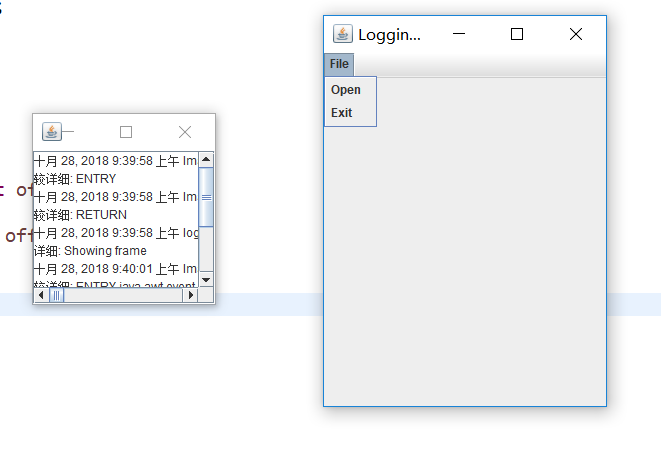
实验程序3:
1.用JDK命令调试运行教材298页-300页程序7-2,结合程序运行结果理解程序;
2.按课件66-77内容练习并掌握Elipse的常用调试技术。
1)条件断点
添加断点:

点击Breakpoint Properties后:
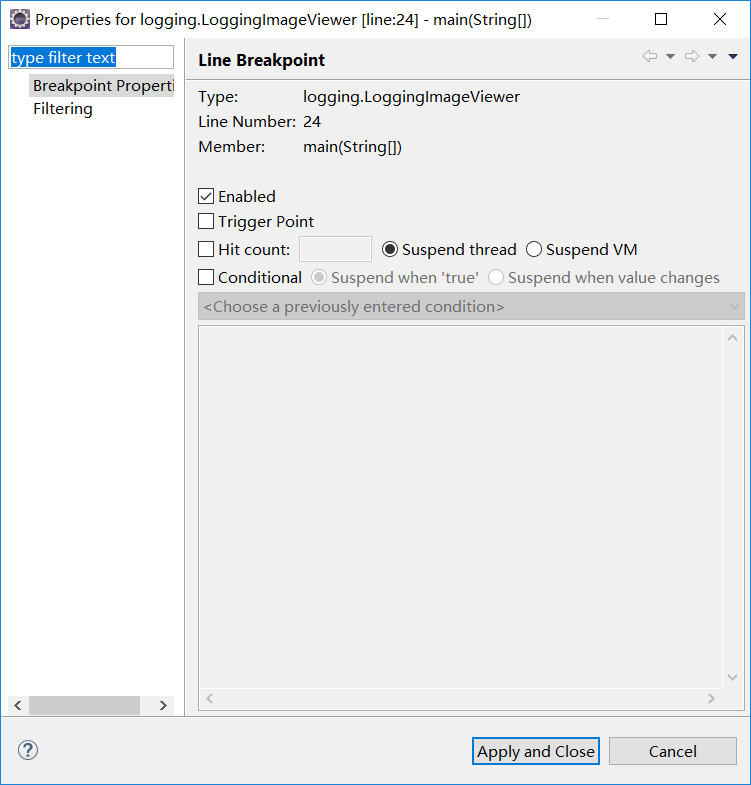
2)变量断点
断点不仅能打在语句上,变量也可以接受断点:

上图就是一个变量的打的断点,在变量的值初 始化,或是变量值改变时可以停止,当然变量 断点上也是可以加条件的,和上面的介绍的条 件断点的设置是一样的。
3)方法断点
方法断点就是将断点打在方法的入口处:
方法断点的特别之处在于它可以打在JDK的源 码里,由于JDK在编译时去掉了调试信息,所 以普通断点是不能打到里面的,但是方法断点 却可以,可以通过这种方法查看方法的调用栈。

4)异常断点
经常遇见一些异常,然后程序就退出来了,要找到异常发生的地方就比较难了,还好可以打一个异常断点。
上图中我们增加了一个NullPointException的异常断点,当异常发生时,代码会停在异常发生处,定位问题时应该比较有帮助。
5)重新调试
6)单步执行程序
7)检查变量
8)改变变量值
第三部分:总结
通过本周的学习,我掌握了java异常处理的一些基础技术;通过调试理解书上的示例程序,再加上老师助、教学长的演示讲解,更好的使我理解这一章的知识。课后的自主编程也是在学长提供思路的基础上理解之后,补充完整的,本周除了惯例的编程练习外,重点是学习Java异常处理技术,更好的运用eclipse这个工具为我们编程提供服务。
王之泰201771010131《面向对象程序设计(java)》第九周学习总结的更多相关文章
- 20155312 2016-2017-2 《Java程序设计》第九周学习总结
20155312 2016-2017-2 <Java程序设计>第九周学习总结 课堂内容总结 两个类有公用的东西放在父类里. 面向对象的三要素 封装 继承 多态:用父类声明引用,子类生成对象 ...
- 20172325 2017-2018-2 《Java程序设计》第九周学习总结
20172325 2017-2018-2 <Java程序设计>第九周学习总结 教材学习内容总结 异常 1.学习了异常的基本概念: 2.区分异常与错误: 一个异常是指一个定义非正常情况或错误 ...
- 20155303 2016-2017-2 《Java程序设计》第九周学习总结
20155303 2016-2017-2 <Java程序设计>第九周学习总结 目录 学习内容总结(Linux命令) 教材学习中的问题和解决过程 代码调试中的问题和解决过程 代码托管 上周考 ...
- 20155321 2016-2017-2 《Java程序设计》第九周学习总结
20155321 2016-2017-2 <Java程序设计>第九周学习总结 教材学习内容总结 JDBC简介 厂商在实现JDBC驱动程序时,依方式可将驱动程序分为四种类型: JDBC-OD ...
- 20145302张薇《Java程序设计》第九周学习总结
20145302 <Java程序设计>第九周学习总结 教材学习内容总结 第十六周 JDBC简介 撰写应用程序是利用通信协议对数据库进行指令交换,以进行数据的增删查找 JDBC目的:让Jav ...
- 20145213《Java程序设计》第九周学习总结
20145213<Java程序设计>第九周学习总结 教材学习总结 "五一"假期过得太快,就像龙卷风.没有一点点防备,就与Java博客撞个满怀.在这个普天同庆的节日里,根 ...
- 21045308刘昊阳 《Java程序设计》第九周学习总结
21045308刘昊阳 <Java程序设计>第九周学习总结 教材学习内容总结 第16章 整合数据库 16.1 JDBC入门 16.1.1 JDBC简介 数据库本身是个独立运行的应用程序 撰 ...
- 20145337 《Java程序设计》第九周学习总结
20145337 <Java程序设计>第九周学习总结 教材学习内容总结 数据库本身是个独立运行的应用程序 撰写应用程序是利用通信协议对数据库进行指令交换,以进行数据的增删查找 JDBC可以 ...
- 《Java程序设计》第九周学习总结
20145224 <Java程序设计>第九周学习总结 第十六章 整合数据库 JDBC入门 ·数据库本身是个独立运行的应用程序 ·撰写应用程序是利用通信协议对数据库进行指令交换,以进行数据的 ...
- 20145236 《Java程序设计》第九周学习总结
20145236 <Java程序设计>第九周学习总结 教材学习内容总结 第十六章 整合数据库 JDBC简介 1.JDBC是java联机数据库的标准规范.它定义了一组标准类与接口,标准API ...
随机推荐
- Lucene入门学习二
接上篇:增删改查 增加:这里不做过多阐述. 删除:删除全部,根据条件删除 修该:先删除,后添加 查询(*):查询所有,精确查询,根据数值范围查询,组合查询,解析查询. package com.ithe ...
- 合并两个git仓库并保留提交记录
case如下: 有2个git仓库:repo1.repo2: 想将repo1中的文件移入repo2: repo1的历史日志要保留: 1 2 # 1.将repo1作为远程仓库,添加到repo2中,设置 ...
- vim 多窗口操作
1.打开多个窗口打开多个窗口的命令以下几个:横向切割窗口:new+窗口名(保存后就是文件名) :split+窗口名,也可以简写为:sp+窗口名纵向切割窗口名:vsplit+窗口名,也可以简写为:vsp ...
- HttpClient学习记录-系列2(源码学习)
如何阅读第三方工具源码? 存在多个入口,而且整个类图存在很多孤岛,自上而下的分析策略貌似不行,还是从use case入手,针对单个面分析.难点是如何做范围界定?不至于陷入黑洞 HttpGet -- ...
- 自己配置 vue 项目 知识体系(自己写脚手架 类似 vue-cli )
简单的目录结构: |-index.html |-main.js 入口文件 |-App.vue vue文件,官方推荐命名法 |-package.json 工程文件(项目依赖.名称.配置) npm ini ...
- 日志系统的 ELK 的搭建
https://www.cnblogs.com/yuhuLin/p/7018858.html 快速搭建ELK日志分析系统 一.ELK搭建篇 官网地址:https://www.elastic.co/cn ...
- CentOS使用systemctl daemon-reload报错Error getting authority: Error initializing authority: Error calling StartServiceByName for org.freedesktop.PolicyKit1: Timeout was reached (g-io-error-quark, 24)解决办法
CentOS修改了系统启动文件后需要重载报错 systemctl daemon-reload Error getting authority: Error initializing authority ...
- Docker命令详解(run篇)
命令格式:docker run [OPTIONS] IMAGE [COMMAND] [ARG...] Usage: Run a command in a new container 中文意思为:通过r ...
- ArcGIS API for JavaScript经典例子
地址为本地 1.绘制图形: http://localhost/arcgis_js_api/sdk/sandbox/sandbox.html?sample=toolbar_draw 2.双击编辑图形 h ...
- 深度学习基础(一)LeNet_Gradient-Based Learning Applied to Document Recognition
作者:Yann LeCun,Leon Botton, Yoshua Bengio,and Patrick Haffner 这篇论文内容较多,这里只对部分内容进行记录: 以下是对论文原文的翻译: 在传统 ...
